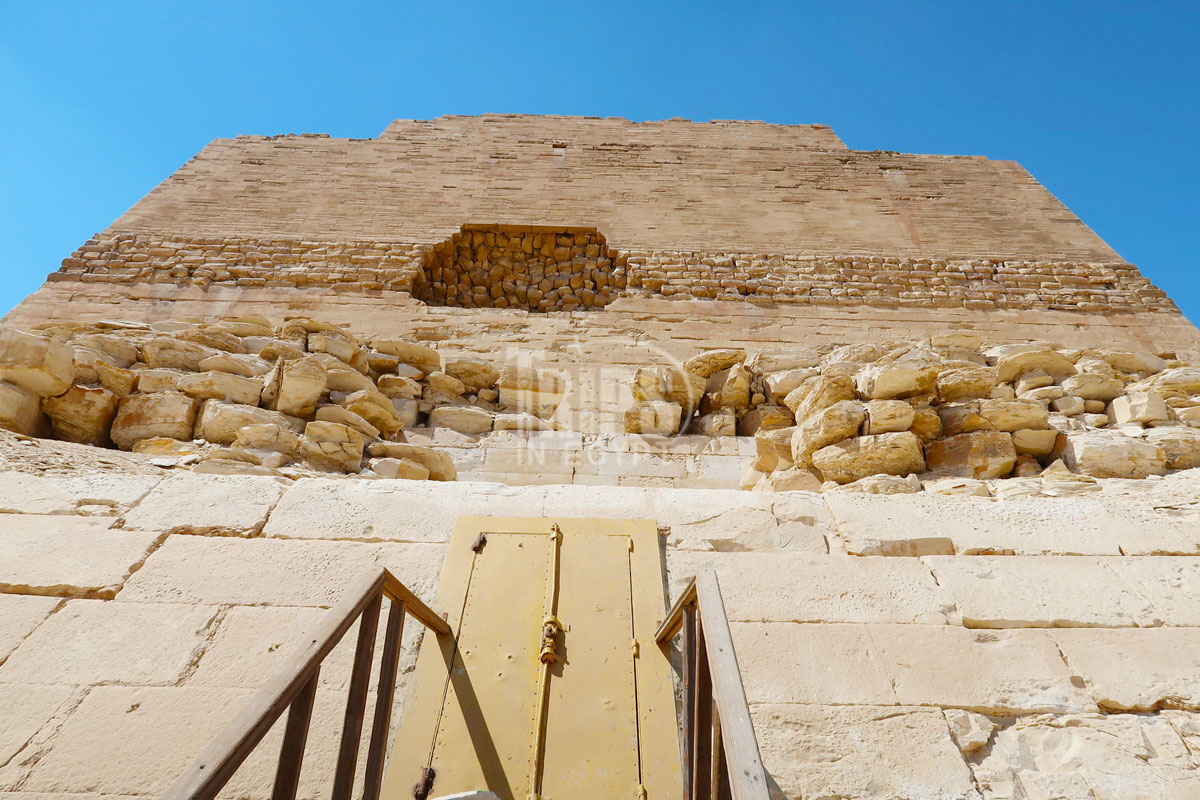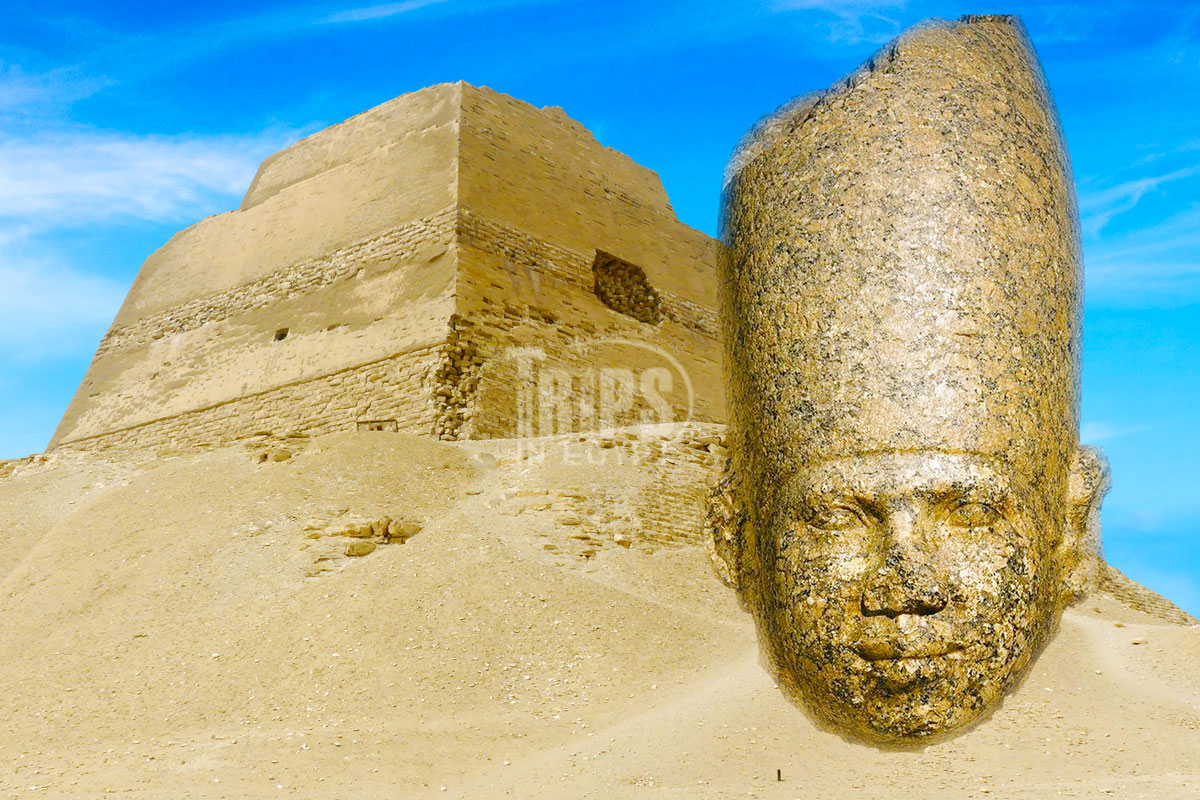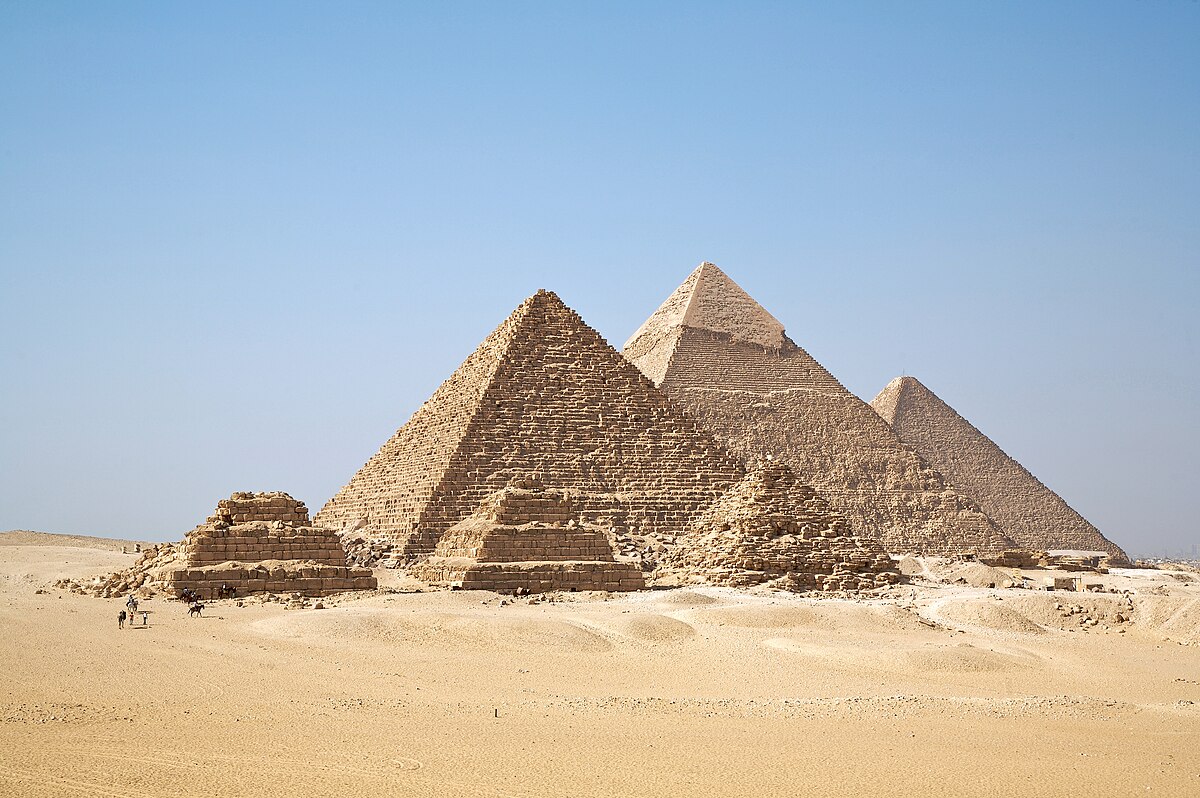Meidum Pyramid: The Unfinished Wonder of Ancient Egypt

Are you ready to journey through time to discover the fascinating world of ancient Egypt? The Meidum Pyramid awaits your exploration! Step into a world filled with wonder and intrigue as we uncover the mysteries of this unfinished marvel.
Overview of the Meidum Pyramid and its historical significance
Welcome to the Meidum Pyramid, a testament to ancient Egypt's rich history and architectural brilliance. Located 62 miles south of Cairo, this pyramid is one of the earliest examples of true pyramid construction.
Originally built for Pharaoh Sneferu, the father of the famous Khufu who commissioned the Great Pyramid of Giza, the Meidum Pyramid was intended to be a grandiose structure representing the strength and power of the ruling pharaoh.
However, what makes this pyramid truly unique is its evolving construction. Initially, it was built as a step pyramid but later transformed into a smooth-sided pyramid. This transformation was unprecedented in ancient Egypt, showcasing its builders' ambitious vision and skill.
Despite its incomplete state, the Meidum Pyramid stands tall as a symbol of determination and innovation. Its historical significance lies in its intriguing construction and the insights it provides into the development of pyramid-building techniques.
While visiting this archaeological marvel, you'll have a chance to marvel at the impressive size and scale of the structure. Explore its chambers and imagine the grandeur that could have been if it had been completed according to its original design.
So, immerse yourself in history as you uncover the mysteries surrounding the Meidum Pyramid. It's an experience you won't want to miss!

Construction and Design
If you're a history buff or fascinated by ancient wonders, the Meidum Pyramid in Egypt should be on your must-visit list. This remarkable structure offers a glimpse into the ingenuity and skill of the ancient Egyptians.
The original design and construction of the Meidum Pyramid
Built during the Old Kingdom period, the Meidum Pyramid was initially intended to be a step pyramid. However, over time, it underwent various architectural modifications. The original construction was carried out by Pharaoh Sneferu, who wanted to create a grand burial monument that would signal his power and legacy.
The architectural features and unique characteristics of the pyramid
The Meidum Pyramid is awe-inspiring in its design and features. It stands at 92 meters (or 302 feet) and has a base measuring around 145 meters (or 476 feet) on each side. Its unique characteristic is that it showcases smooth-sided and stepped designs, making it a fascinating blend of different architectural styles.
The pyramid also boasts an intricate system of internal corridors and chambers. These were intended to house the pharaoh's burial belongings and treasures. Its construction techniques, such as using large limestone blocks, demonstrate the advanced engineering skills possessed by the ancient Egyptians.
Despite its impressive construction, the Meidum Pyramid remains unfinished. It is believed that the pyramid's structural instability became evident due to architectural flaws during its construction. As a result, further attempts to complete it were abandoned.
Visiting the Meidum Pyramid today allows you to marvel at its remarkable design and the mysterious history behind its unfinished state. Standing in its shadow, you can't help but be in awe of the ancient Egyptians' ambition and architectural achievements.

Transformation and Unfinished State
If you ever find yourself exploring the wonders of Ancient Egypt, visit the mesmerizing Meidum Pyramid. This architectural masterpiece stands as a symbol of the transformation and resilience of the ancient Egyptians.
The transformation of the Meidum Pyramid from a step pyramid to a true pyramid
The Meidum Pyramid is a unique structure that showcases the development of pyramid-building techniques. Originally built as a step pyramid by Pharaoh Sneferu, it was later transformed into a true pyramid. This transformation involved adding casing stones to smooth out the structure's exterior and create the iconic triangular shape we associate with pyramids today. This evolution in design marks an important milestone in Egyptian architecture, paving the way for future pyramid constructions.
Reasons for the pyramid's unfinished state and abandonment
Despite its remarkable beginnings, the Meidum Pyramid remains an unfinished wonder to this day. Scholars believe that Pharaoh Sneferu's ambitious plans for the pyramid led to its premature abandonment. Construction techniques were still being refined during this time, and structural issues began to arise as the pyramid grew taller. The pyramid's inner core could not support the weight of additional layers, causing instability.
Over time, significant cracks appeared in the structure, resulting in its abandonment. These engineering challenges ultimately prevented Sneferu from completing his grand vision for the Meidum Pyramid. However, despite its unfinished state, this ancient monument still captivates visitors with its sheer size and powerful presence.
Visiting the Meidum Pyramid offers a glimpse into ancient Egypt's rich history and ingenuity. Witness firsthand the transformation from a step pyramid to a true pyramid and marvel at the astonishing craftsmanship that went into its construction.

Interior Structure
Regarding iconic structures from ancient Egypt, the Meidum Pyramid often gets overshadowed by its more famous counterparts, like the Great Pyramid of Giza. However, this unfinished wonder still holds a certain intrigue and mystique that shouldn't be overlooked.
Exploration of the interior chambers and passages of the Meidum Pyramid
As you step inside the Meidum Pyramid, you'll find a complex network of chambers and passages waiting to be explored. Unlike the pyramids that came after it, such as the Pyramids of Giza, the interior layout of the Meidum Pyramid is less straightforward.
The Meidum Pyramid was originally built as a step pyramid and later modified into a true one. This transition created an intricate interior design with multiple levels and chambers. From the entrance on the northern side, you can venture into various corridors and chambers, each offering glimpses into the architectural prowess of ancient Egypt.
Discoveries and artefacts found within the pyramid
Within the depths of the Meidum Pyramid, archaeologists have uncovered fascinating artefacts and discoveries that shed light on the lives and beliefs of ancient Egyptians. Hieroglyphics adorn the walls, depicting scenes from religious rituals and daily life.
One noteworthy discovery was a false door that was believed to be an entrance to the afterlife. This indicates that religious beliefs played a significant role in ancient Egyptian culture. Additionally, evidence of burial chambers suggests that this pyramid served as a tomb for an important ruler.
Visiting the Meidum Pyramid offers a unique opportunity to witness an unfinished wonder from ancient Egypt. Exploring its interior will transport you back in time as you uncover fascinating artefacts and marvel at the architectural achievements of this enigmatic structure.
The Bent Pyramid Controversy
If you're fascinated by the wonders of Ancient Egypt, then you must have heard of the Meidum Pyramid. This architectural marvel, located in the desert of Saqqara near Cairo, is often called the "Unfinished Wonder." But what makes it so intriguing?
The connection between the Meidum Pyramid and the Bent Pyramid of Dahshur
The Meidum Pyramid is believed to have been built during the reign of Pharaoh Sneferu, one of the early pharaohs of the 4th Dynasty. It is considered an important milestone in the evolution of pyramid construction techniques.
Interestingly, the Meidum Pyramid is closely connected to another remarkable pyramid - the Bent Pyramid of Dahshur. These two pyramids share many similarities in terms of design and structural features. Some experts even believe that the Bent Pyramid was initially planned as an extension of the Meidum Pyramid.
Controversies and theories surrounding the two pyramids
Despite their connections, both pyramids have faced controversies and raised intriguing theories. One notable controversy surrounding the Meidum Pyramid is its unfinished state. It was originally envisioned as a stepped pyramid but was later modified into a true pyramid shape. However, this modification wasn't completed, leaving behind a structure resembling a collapsing or dilapidated pyramid.
The Bent Pyramid's unusual bent shape has sparked numerous theories about why it deviates from the traditional pyramid design. Some experts believe construction errors forced a plan change, resulting in a unique bent structure. Others suggest that architectural experimentation played a role.
Regardless of these controversies and theories, both pyramids continue to capture the imagination of tourists and Egyptology enthusiasts. Their historical significance and architectural beauty make them must-visit destinations for anyone interested in ancient civilizations. So, if you find yourself in Egypt, don't miss the chance to explore these fascinating structures.

Restoration and Preservation Efforts
If you're a history enthusiast or intrigued by ancient wonders, you must have heard about the Meidum Pyramid. This iconic structure, located in Egypt, has a fascinating history that dates back thousands of years. Let's examine the restoration and preservation efforts to maintain this unfinished wonder.
Efforts to restore and preserve the Meidum Pyramid
Structural Stability: The Meidum Pyramid, believed to have been built during the reign of Pharaoh Sneferu, has faced significant challenges over the centuries. The structure suffered structural collapses, leaving it in a deteriorating state. However, restoration experts have worked diligently to stabilize the pyramid and prevent further damage.
Conservation Techniques: Various conservation techniques have been employed to protect the ancient monument from weathering and erosion. These include cleaning the exterior surfaces, removing harmful vegetation, and applying protective coatings to safeguard the stones from deterioration.
Documentation and Research: Detailed documentation and research have been conducted better to understand the pyramid's construction techniques and historical significance. This involves examining the architectural features, analyzing ancient inscriptions, and studying the materials used in their construction. By uncovering these details, experts can develop effective preservation strategies.
Tourism and Public Awareness: Restoration efforts have focused on physical repairs and raising public awareness about the site's historical value. By promoting tourism and providing educational resources, more people are becoming aware of the significance of this ancient wonder. This increased attention helps generate support for ongoing preservation initiatives.
The Meidum Pyramid stands as a testament to the advanced engineering skills of ancient Egyptians. With ongoing restoration efforts and a commitment to preservation, this unfinished wonder will continue to captivate visitors for generations to come.
Meidum Pyramid in Ancient Egyptian Culture
The Meidum Pyramid is an intriguing structure that holds a special place in ancient Egyptian history and culture. As you explore this majestic wonder, you will discover its significance in ancient Egyptian beliefs and rituals and its role in the afterlife and religious practices.
The significance of the Meidum Pyramid in ancient Egyptian beliefs and rituals
The Meidum Pyramid was built during the reign of Pharaoh Sneferu, the father of Khufu, who constructed the Great Pyramid of Giza. This pyramid was initially designed as a step pyramid but underwent multiple modifications, which gives it a unique appearance.
In ancient Egyptian culture, pyramids were colossal tombs and symbols of power and divine authority. The construction of the Meidum Pyramid represents the devotion of Sneferu to affirm his reign as a strong and legitimate ruler.
Its role in the afterlife and religious practices
For the ancient Egyptians, death was not the end of life but rather a transition to the afterlife. The Meidum Pyramid was believed to be a gateway for Pharaoh Sneferu's soul to ascend to the heavens and join the gods.
The pyramid's intricate burial chambers were designed to house Pharaoh Sneferu's body and precious offerings for his journey into eternity. The walls were adorned with hieroglyphics depicting religious rituals and spells that would guide his soul through the afterlife.
Additionally, these pyramids were seen as powerful conduits between earthly and divine realms. Devout Egyptians would make pilgrimages to these sacred sites to pay homage to their gods and seek blessings for themselves and their loved ones.
The Meidum Pyramid is a testament to the ancient Egyptians' unwavering belief in the eternal nature of life and their commitment to honouring their pharaohs, even in death. Its grandeur and allure continue to captivate visitors worldwide, reminding us of the extraordinary civilization that once thrived along the banks of the Nile.

Tourist Experience
Are you ready for an extraordinary adventure in ancient Egypt? The Meidum Pyramid awaits you, an unfinished wonder that has captured the imagination of travellers for centuries. Get ready for a journey back in time!
Visiting the Meidum Pyramid: What to expect and how to get there
Getting to the Meidum Pyramid is an adventure in itself. Located about 60 miles south of Cairo, hiring a guide or joining a tour group is best to ensure a smooth journey. The trip takes you through the beautiful Egyptian countryside, giving you a glimpse of the rural life surrounding this historic site.
Once you arrive, be prepared to be amazed. The Meidum Pyramid, or the collapsed pyramid, is a unique sight to behold. Its distinctive shape and steps make it different from other pyramids in Egypt. Although it remains unfinished, it still stands tall as a testament to the incredible craftsmanship of ancient Egyptian architects.
Tips for exploring and appreciating the pyramid
-
Climb to the top: Yes, you can climb the pyramid! Ascend its steps and reach the top for breathtaking panoramic views of the surrounding landscape. Just be careful and watch your step.
-
Explore the interior: Step inside the pyramid and discover its chambers and corridors. Some believe that hidden treasures or secrets may still lie within these ancient walls.
-
Take memorable photos: Capture this incredible experience by taking plenty of photos. The Meidum Pyramid's unique design offers numerous photo opportunities that will impress your friends and family back home.
-
Learn from your guide: Make the most of your visit by engaging with your guide or tour group. They can provide interesting insights into the pyramid's history and architecture, giving you a deeper appreciation for this ancient wonder.
So, put on your explorer hat and prepare to be awestruck by the Meidum Pyramid. This unfinished wonder of ancient Egypt is waiting to transport you back in time and leave you with memories that will last a
